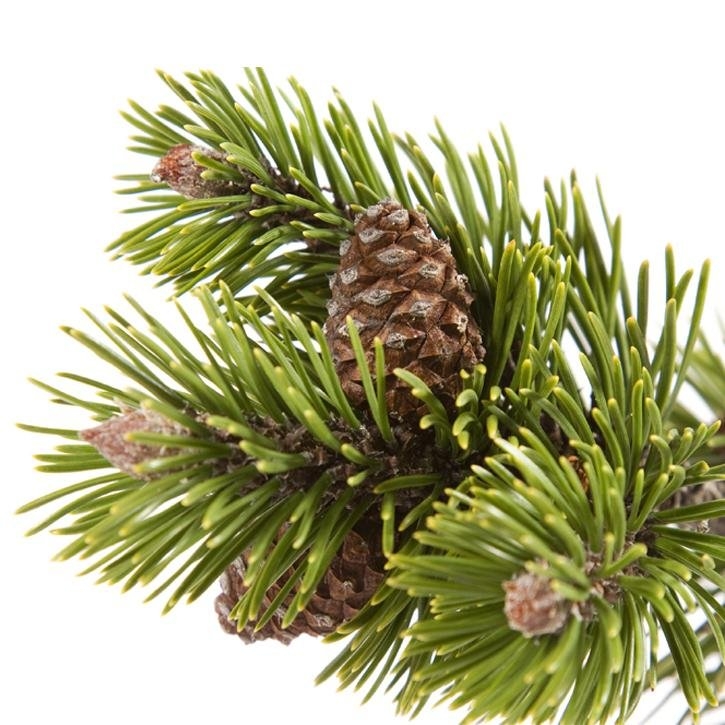Buds are reddish. Leaves are persistent acicular, rigid, dark green grouped on the tip of strong shoots, twisted by pairs circular in cross section no longer than 6 cm. Flowers have male inflorescences of sulphur-like yellow; female ones are those known as small cones. Female strobiles are small and fructiferous. Purple cones have plenty of scales and a large peduncle. Each scale represents a female flower. It belongs to the Pinaceae family.
It blooms in spring and seeds maturation take place at autumn of the following year. This is the most popular pine in Europe and Asia.
This pine does not demand specific soil characteristics; however, it seems to prefer sandy, slope and fresh soil. It also grows in limestone ground and even in soils with gypsum content. Normally it grows in silicic and basic soil types, but it can survive even in very humid lands. In regards to altitude, it is located between 1,000 and 2,000 m, with the optimum location towards 1,500 m. It requires a high level of light, thus won’t fully grow under shadows and needs to be cleared often. It grows rapidly and may live up to 400-500 years.
Pine is susceptible to southwestern dwarf mistletoe; it has micorrhizas with different kind of fungi, the saffron milkcap (Lactarius deliciosus) among them.
Leaves (needles), young branches, buds, essence (obtained by leaves and young branches distillation) and sometimes the bark and the tar are used, as well.
Leaves and buds
Bark
- Jean Bruneton. Farmacognosia. Fitoquímica Plantas Medicinales. 2ª Edición. 2001. Ed Acribia. S.A.
- Bulletin officiel Nº 90/22 bis. Ministère des Affaires Sociales et de la Solidarité.
- French Public Health Code.
- Plantas Medicinales. Margarita Fernandez y Ana Nieto. Ed Universidad de Navarra. EUNSA 1982.
- Matière Médicale (tomo I). RR Paris- H. Moyse. Masson 1981.
- The Complete German Commission E Monographs. Therapeutic Guide To Herbal Medicines. Mark Blumenthal. American Botanical Council 1998.
- Pharmacognosy, Phytochemistry, Medicinal Plants. Jean Bruneton. Lavoisier Publishing.
- Fitoterapia: Vademecum de Prescripción. Plantas Medicinales. Colaboran: Asociación española de médicos naturistas. Colegio Oficial de Farmacéuticos de Vizcaya.
- Fitoterapia Aplicada. J.B. Peris, G. Stübing, B.Vanaclocha. Colegio Oficial de Farmacéuticos de Valencia 1995.
- Pharmacognosy 9th edition. Varro E. Tyler – Lynn R. Brady – James E. Robbers.
- Guía de las plantas medicinales. Paris.
- PDR for Herbal Medicines. Medical Economics Company, Montvale. Second Edition. 2000; pp 674-7.
- Blumenthal M, Goldberg A, Brinckmann J. Herbal Medicine, Expanded Commission E Monographs. Integrative Medicine Communications, Newton. First Edition, 2000; pp 304-6.
- Benigni, R; Capra, C; Cattorini, P. Piante Medicinali. Chimica, Farmacologia e Terapia. Milano: Inverni & Della Beffa, 1962, pp.1107-9.
- Bézanger-Beauquesne, L; Pinkas, M; Torck, M. Les Plantes dans la Therapeutique Moderne. 2ª. Paris: Maloine, 1986, pp. 334-6.
- Bézanger-Beauquesne, L; Pinkas, M; Torck, M; Trotin, F. Plantes Médicinales des Regions Tempérées. Paris: Maloine, 1980, p.32.
- Mulet, L. Estudio Etnobotánico de la Provincia de Castellón. Castellón: Diputación Provincial, 1991, pp. 336-7.
- Trease, GE; Evans, WCh. Farmacognosia. México D.F.: Interamericana--MacGraw-Hill, 1991, p. 472.
- Van Hellemont, J. Compendium de Phytotherapie. Bruxelles: Association Pharmaceutique Belge, 1986, pp. 292-4
